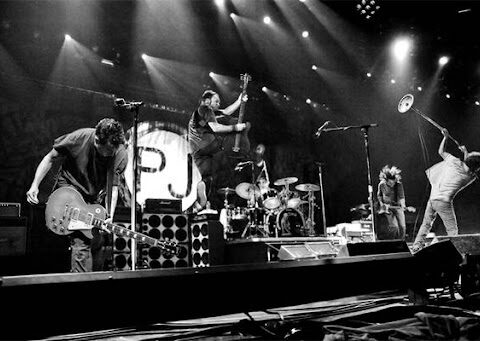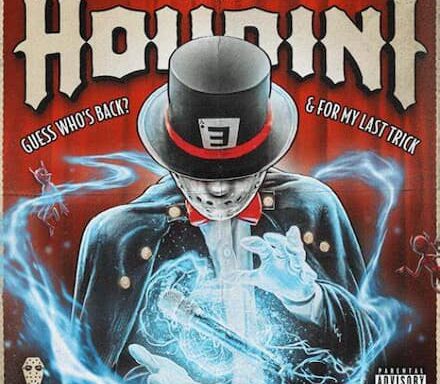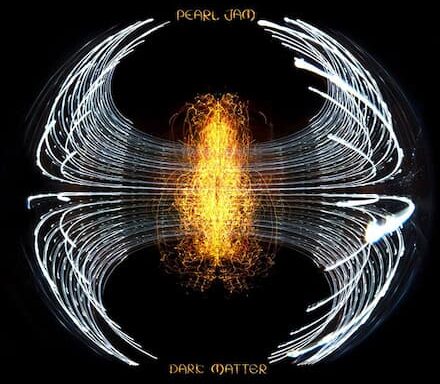‘The 20 Greatest Album Covers’ according to The Burning Blogger, of course, which means there will be disagreements; as this list is limited to album covers I am aware of.
But I did look a little at covers outside of my own album collection to make sure I wasn’t missing out any absolute musts.
This list, just to clarify, is about the cover art, not necessarily the music itself – for example, I’m not a Led Zeppelin fan. However, at least seven or eight of the albums listed here would also make my all-time best CD list as well.
What makes a great album cover is a multi-faceted question. It could be just something very cool or iconic (most Bjork covers, for example, for the sheer photogenic and iconic nature of Bjork herself). Or it could go beyond that; an image that really aptly represents that album and its music (Joy Division – Closer, for example).
Or, more interestingly, a theme that carries through the entire piece of art, being a marriage of music and visual art (Nirvana’s In Utero, for example, with its stunning pregnant angel, has incredible artwork continuing the theme, as well as lyrics across the album that refer to pregnancy, childbirth, death, and the life cycle).
Or something that resonates with a specific moment in time or evokes a specific era, ensuring future nostalgia (Hole’s Live Through This).
Or in some cases it might be something complicated or esoteric, so that the album cover itself becomes a kind of puzzle to be pondered; Michael Jackson’s Dangerous, for example.
In any case, here’s the top twenty – in no particular order – that I’ve filtered it down to. You’re bound to disagree with some. If so, let the argument commence…
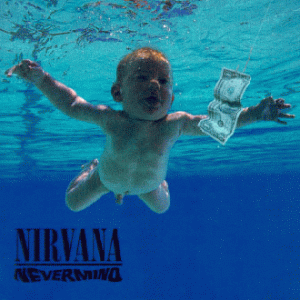
NIRVANA – Nevermind
A baby, representing innocence, thrown into a corporate world to chase the almighty dollar. Says everything about the social and political backdrop of the era, says much about Nirvana, and in part about what the best alternative bands were reacting to, coming out of the 1980s and into the 1990s.
It’s almost certain that the image of the baby chasing the dollar is meant to represent Nirvana’s move to a major record label: sort of leaving behind the innocence of the underground and entering a more corporate or commercial world. That the album ended up at No.1 on the charts (displacing Michael Jackson), became a game-changer event, and turned Nirvana into a phenomenon, makes the dollar imagery seem prophetic.
The image of the baby (Spencer Eldon) in the blue water is one that really captures a moment in time. Fitting that such an iconic album should also have such an iconic and instantly recognizable cover representing it.

MILES DAVIS – Bitches Brew
The work of famous and eclectic artist, Abdul Mati Klarwein, it is a suitably surrealist and evocative piece of art to package so monumental an album as Miles Davis’ Bitches Brew (1970). Widely considered to be Miles Davis’s best album and a watershed piece of work in popular music history, the imagery is the kind of visual experience you can get lost in.
It no doubt was even more striking in LP form in its 1970 release than it looks today on scaled-down CD sleeves or Internet image searches. This is an image that captures the imagination and draws you into its esoteric mystery.

LED ZEPPELIN – Houses of the Holy
I’m not a big Zeppelin fan; but this artwork for this album is one of the most striking and evocative covers you’ll ever see. It’s striking just on first glance alone; before you even find out any background story to the image.
The cover is in fact a collage of several photographs that were taken at the Giant’s Causeway in Northern Ireland, by Aubrey Powell. Which is a stunningly epic and mythic location to stage images for an album cover.
Moreover, the image of the children climbing the rocks is apparently inspired by Arthur C. Clarke’s 1953 science fiction novel Childhood’s End: and specifically the novel’s climatic event, in which all the children in the world gather together, merge into a burning column, and depart the Earth.
The photo shoot featured two children, Stefan and Samantha Gates: and it’s kind of extraordinary – and maybe a little unsettling? – to know that they were both actually naked for these shoots.
At any rate, it’s a very evocative piece of visual art: all the more, given the supposed inspiration. Something also has to be said about the highly effective use of tinting and colour manipulation that gives the image its off-kilter, surreal feel.

HOLE – Live Through This
Another iconic image representing another watershed album. Hole’s second album – and commercial debut – was a bruised masterpiece of a record, released under extraordinary circumstances in 1994. The cover image, featuring model Leilani Bishop, is as iconic as the music it is attached to.
Shot by photographer Ellen von Unwerth, the woman is shown dressed in beauty pageant attire with a tiara and a bouquet of flowers, with mascara running down her eyes in tears of joy.
The image of the coronation of the homecoming queen-type figure clearly correlates to the music video for the ‘Miss World‘ single (the first single released from the album), with its Carrie-like themes and imagery. But it seems obvious that the woman is a representation of Courtney Love herself: experiencing her own ‘coronation’ or crowning moment as a breakthrough artist or musician breaking into the commercial scene (which is what Live Through This was meant to be: Hole’s contract with Geffen was the most lucrative ever signed at the time, exceeding Nirvana’s).
Of course, both the ‘Miss World’ video and the Live Through This cover image manage to also depict that this crowning moment or triumph is bittersweet and that all is not what it appears to be: and this is part of the dissonance that makes this imagery so potent. It may help that we know the release of the album literally coincided with the suicide of Courtney’s husband, Kurt Cobain: quite literally making Live Through This a kind of planned or expected coronation that was instead bathed in tragedy and sadness.
With all of that borne in mind, there’s something that remains so moving about that Leilani Bishop image: and its sense of short-lived or even ominous elation.

THE DOORS – Full Circle
Not my favorite album by The Doors, by any means. But the 1972 record (recorded without the by-then deceased Jim Morrison) was considered “one of the most creative album covers of all time” by Rolling Stone. Illustrated by Joe Garnett, based on concepts by Ernie Cefalu, it is certainly an engaging and fascinating work of art, whatever its ultimate meaning.
As an abstract painting – let alone as an album cover – it is fascinating; a piece of art you’d happily have on your wall or in an art collection. The Sphinx-like object in the water is the element that makes we wonder the most what the message is.

SCREAMING TREES – Uncle Anesthesia
The cover artwork for the Seattle band’s major-label debut was by Mark Ryden. Again, not the Screaming Trees best album necessarily (though it does have some great tracks; and it was co-produced by Chris Cornell, by the way), the off-beat cover art is fascinating. There’s clearly some kind of lab technician there involved in whatever nightmarish scenario is going on: and some kind of puppet-like golem. What the little girl holding the demonic-looking baby is about, I do not know.

NIRVANA – In Utero
The cover image for Nirvana’s third and final album is, again, fascinating and iconic. In fact, all of the artwork permeating that album is fascinating: in particular Cobain’s foetus collage. But the sparse image of the pregnant angel is just something that really captures or focuses the imagination.
Kurt Cobain was fascinated with childbirth, pregnancy, life and death: both in general and specifically at the time of writing and conceiving In Utero. His wife, Courtney, had just given birth and he had become a father. This fascination with the life cycle and the reproductive process permeates the final Nirvana album, featuring in lyrics as well as in the visual art.
The pregnant angel figure also appears (albeit in slightly different form) in the equally iconic music video for the album’s main single, ‘Heart Shaped Box’: and the angelic figure also featured as part of the evocative set design on Nirvana’s In Utero tour.

SMASHING PUMPKINS – Melloncollie & the Infinite Sadness
One of the definitive albums of the 1990s, Smashing Pumpkins’ legendary double-album was a masterclass both musically and artistically: the album seemingly based around unifying themes of night and day, cosmic mystery and the moon and stars, in some cases as metaphor and in some cases maybe literally.
The entire thing seems to have been conceived as something beyond just music; with the visual art aspect being afforded a great deal of attention. As a package – encompassing not just the cover art, but the sleeve art and various paintings featured in the inner packaging – what Billy Corgan and co created was a living, multi-faceted work of art.
All of the paintings are fascinating and endearing, evoking a mixture of Renaissance-style visuals and child-like conceptions, often with a Victorian tinge. This also carried through into some of the music videos, particularly for the album’s opening song and lead single, Tonite, Tonite – which has an extraordinary music video. The main cover image itself is always striking: showing a Renaissance-art styled female figure moving through the cosmic void. It evokes the sense of cosmic mystery, as well as an accompanying sense of loneliness.
The album’s art is the work of illustrator and collage artist John Craig, who created the cover image based on images from an old children’s encyclopedia. In fact, the main cover image was created by combining two different paintings: the woman’s face is taken from Jean-Baptiste Greuze’s painting, The Souvenir; while the body is taken from Raphael’s Saint Catherine of Alexandria. And it is fascinating to go look at the original, old paintings and then to come back to the Melloncollie cover.
Definitely iconic.

MICHAEL JACKSON – Dangerous
I don’t know what Michael Jackson was trying to do here. But, with this album cover for his 1991 album, the idea of the squeaky-clean pop prince stopped applying to MJ: you can’t retain that wholesome 80s pop image and Peter Pan innocence motif when you come up with an album cover like this one (a cover that, allegedly, contains an image of Alistair Crowley on it).
Created “the god-father of pop surrealism” Mark Ryden (who’s name you’ll notice appears several times in this article in regard to album covers), the most base-level reading of this complex image is that it is based on a circus motif. Which kind of makes sense if MJ was commenting on the extent to which his life had become a circus.
So what’s going on here? I mean, a lot. For one thing, there’s the All-seeing eye above the twin masonic pillars. The image is also full of references to royalty and royal symbols, as well as Egyptian imagery. The globe depicting the Earth appears to be upside down; which probably symbolises something.
The old man at the bottom has been identified by different observers as either PT Barnum, the notorious occultist Aleister Crowley, or as Adam Weishaupt (founder of the Bavarian Illuminati). I think, in keeping with the circus motif, it makes the most sense that it is PT Barnum. However, the Crowley theory would seemingly fit with the masonic images and the Egyptian motifs, so who knows? And, if it is Crowley, it’s interesting: because the infamous ‘Beast 666′ also appears on another iconic album cover – specifically, the Beatles’ Sgt. Pepper’s cover. And there are connections between Michael Jackson and the Beatles too.
It’s curious too that the imagery here seems to correlate with the imagery from Michael Jackson’s music video for Leave Me Alone: with the circus motif and the idea of the fairground-type ride going through the tunnel. But that single – and its fantastic music video – wasn’t even from the Dangerous album; but from the Bad album a few years earlier. Which makes this even more odd.
Either way, the Dangerous cover is a riddle. A bit like Jackson himself. Clearly, he was trying to convey something.

BLIND MELON – Blind Melon
As with some of the other album covers listed here, the ‘Bee Girl’ also appeared beyond the cover itself: the child Heather Lauren DeLoach appeared in Blind Melon’s music video for the hit single ‘No Rain’, where she flitted and tap-danced her way into viewers’ hearts in 1992.
It’s an iconic image: both in the life-affirming music video and gracing the cover of Blind Melon’s debut album. Like both the In Utero and Live Through This covers, it’s interesting how the simple image of a solitary figure can be so arresting or iconic: as opposed to something more complicated or busy.
But just thinking about the Bee Girl and this cover makes me smile.

JIMI HENDRIX EXPERIENCE – Axis Bold As Love
The cover to Hendrix’s second album in 1967 is visually striking, depicting Hendrix as his bandmates as central figures in a Hindu pantheon of gods. Needless to say, this album was released at the height of the hippy counter-culture movement, of which Hendrix was a key icon, and in which eastern mystical or religious ideas were crossing into American culture. The Axis cover captures this mood or zeitgeist very well.
However, it is known that Hendrix himself wasn’t the driving influence behind Roger Law’s artwork for the album: it was the record label that had wanted the eastern/Indian influence for the cover art (as it was very trendy at the time, particularly after the Beatles’ experiences in India), whereas Hendrix himself had wanted something more connected to Native American Indian culture.
Nevertheless, it has long since become iconic imagery: possibly the most iconic imagery to be associated with Hendrix.

PUBLIC ENEMY – Muse Sick-N-Hour Mess Age
The fifth studio album by the groundbreaking and iconic hip-hop pioneers, released in 1994 to mixed reviews and opinions. But the album has clever language and word-play (even in its title); and a superb piece of incisive cover art, which – like the group and its music – takes no prisoners.
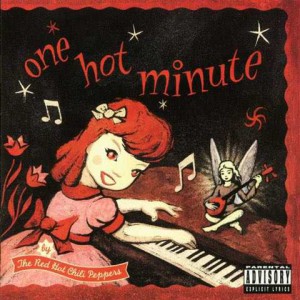
RED HOT CHILLI PEPPERS – One Hot Minute
1995’s One Hot Minute might in fact be my favorite Chili Peppers album, even if its the most underrated and overlooked. Mark Ryden’s artwork for the cover has always captured my imagination; although I don’t think it necessarily relates to any of the songs specifically or to any underlying theme on the record.

FRANK ZAPPA – 200 Motels
A complex one, this: an album containing the soundtrack to a film of the same name, which was actually a rock n’ roll mockumentary directed by Zappa himself.
The surreal 1971 film is an oddity in itself, involving various big rock n’ roll names, though it was a fiction parading as real life. The album contains a massive amount of music, varying in quality. But the art/cover really does draw you in to a world. Some might consider the image a little too busy, a little too over-stuffed; which is true, but it still draws you in and makes you want to know what’s going on.
And Frank Zappa’s face staring straight at us from the top center of the complicated diorama is a striking feature.
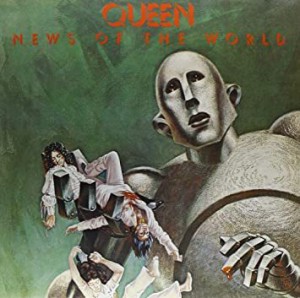
QUEEN – News of the World
Not Queen’s best album; but the cover art has become iconic. The slightly unsettling sci-fi image (which terrified Family Guy’s Stewie Griffin in one episode of the TV series) was the work of SF artist Frank Kelly Freas and originated in a March 1954 edition of Astounding Science Fiction.
Queen solicited Freas some two decades after the publication of his original painting and asked him to adapt the imagery for their purposes. It’s a really great album cover.

STONE TEMPLE PILOTS – Purple
Yeah, I don’t know. I’ve always loved this image: and I love the album, which is probably STP’s best record. But I have no idea what the image is signifying. As far as I can tell, it doesn’t relate to any of the songs or lyrics on the album.
I’m told by other analysts’ that the child in the colourful image is riding on a Qilin accompanied by a quintet of fairiy-type figures. What does it mean? No idea. But it’s a great image: for a great album.

BABES IN TOYLAND – Nemesisters
A great piece of art; for a very underrated album by one of my all-time favourite bands. It’s just an infectious, gleeful image, with its fairground or house-of-horrors style theme, depicting Kat and the other band members as freaks or chimeras. Great use of font too, to evoke that early 1900s style freak-show imagery; and great use of colour. I wish I had this as a poster.

BUTTHOLE SURFERS – After The Astronaut
An interesting one, this. A cover to an album that was, technically, never released: but which was eventually released a few years later under a different name and with a different cover. But this cover has always struck me; it’s kind of simple in a way, but it also embodies all of the Butthole Surfers’ tendency towards absurdity, satire and pop culture subversion.

BEATLES – Sgt Pepper’s Lonely Hearts Club
I’m not necessarily a huge fan of the album; but the cover is undeniably iconic. In fact, it might be a contender for the most famous album cover of all time. And, despite being very over-stuffed, it is a very difficult image to not stare at at length. I almost didn’t want to include it – just because it’s too obvious.
Arguably, this image is too busy: too many people and things going on, in contrast to some of the other covers included on this list, which are much more focused and simple. But you can’t help but examine it at length: which means, it is doing its job. Whole articles have been written elsewhere, picking out all the details, symbolic references or meanings: but,among the curious pantheon of cultural or pop-cultural figures on display are T.E Lawrence, Carl Jung, Aldous Huxley, Alistair Crowley, H.G Wells, Laurel and Hardy, Jane Mansfield, Gandhi and Edgar Allen Poe.
Curious to note that, among the figures also intended to feature in the line-up but omitted at the last minute, were Adolf Hitler and Jesus.

THE MELVINS – Electroretard
The Melvins generally have good album covers and art, usually odd ones – as befitting their style and outlook. Frank Kozik’s cartoon cover for Electroretard is a perfect slice of oddball, off-beat Americana: that perfectly dissonant mix of classically idyllic American cartoon iconography with off-beat, slightly sinister undercurrents.
I don’t know why the kid is handing the wheelchair lady a spider. But why not?
___________________________
So there’s my final selection. I’ve made my bed and will have to lay in it. Have I majorly overlooked something that should’ve been here? If I have, let me know.
___________________________

